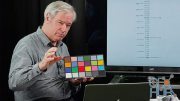

SplineWrap to deform geometry along the splines.Ĭlass 8: Animating the graphic elements appearing through the shot. Cloner Object to clone graphics along the splines. Using the knife tool to create cuts for generating splines from the tunnel geometry. The render passes will be created, output and brought into the composite for review.Ĭlass 7: Creating the graphic elements in Cinema4D. This is the first blocking stage and we will attempt to animate all the elements and prepare them for output. Outputting out a still frame using multipass render layers will give us the opportunity to develop our style frame.Ĭlass 6: 3D Animation, Render and Comp – In this class we will animate the 3D elements. Any problems associated with this and allowing us plenty of time to find solutions. This will also allow us to develop our 3D – 2D pipeline for the project, discovering which passes need to be rendered. We will build proxy elements of the live action plate from the tracking data which we will use as shadow catchers and other composite helpers. Exporting python script for C4D.Ĭlass 5: Style Frame, Render and Comp – Taking the tracking data into Cinema4D we can start to incorporate 3D elements into the live action plate. Using supervised tracking we will track and solve the tunnel shot. We also look at an alternative method available when using the Correction Deformer.Ĭlass 4: Tracking the tunnel shot in Syntheyes. Covering many of the most commonly used tools when modelling with hyperNURBS including, knife, edge cut, extrude, loop and ring selection. We will also discuss important concepts such as file management and organising your projects.Ĭlass 3: Model the joystick in Cinema4D. We will work with masks, 3D layers, parenting, shape layers and time-remapping. Although the work is quite simple, it is an essential part of the process and this will create a solid foundation for building upon over the following weeks. Whilst working with RED Cine we explore some of the looks we could output when we grade our shot.Ĭlass 2: This week we create the animatic for the ident using Adobe After Effects CS5.5. Tim shares his experiences of working with the RED Epic and after a brief overview of working with RED Cine, we choose our selects from the RED footage.

From this selection of ideas, one is chosen and we discuss a practical approach to shooting the footage. Finally, 2D graphic elements will be added and animated in post and the grading completed ready for final rendering.Ĭlass 1: Concept Development – We look at the initial boards created for the ident and the concepts and scripts behind them. The indent will progress as the 3D multipass renders are output and the composite is developed. The term will continue with elements being animated in both 2D and 3D. Bringing all of this together in the form of style frames which will be the foundation for the ident look, grade and overall feel. Creating elements using 3D modelling and texturing techniques in Cinema4D. We will be working with Adobe Illustrator to develop various designs and graphic features. Alongside creating our animatic and completing technical tasks such as tracking and modelling, we will also be exploring design options throughout the production. Once the animatic is complete, the footage will be tracked and the 3D solution exported ready for match moving.Īn important part of any production is the design process and this will be an integral part of the course. Next, we will take the selected clip into the animatic stage within Adobe After Effects, using this as a tool to block out our basic design and timing.

Working with footage which was shot on the RED Epic, we will be choosing selects from our bin of clips and exploring various grade options within RED Cine. Starting with design and concept, we then move on to discuss the shoot itself. The structure and workflow of this course will be similar to the typical studio workflow you would find when working on a real world production.


 0 kommentar(er)
0 kommentar(er)
